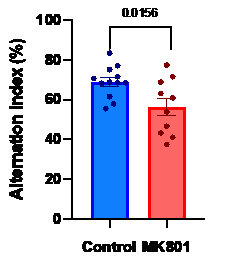35-day mice are implanted subcutaneously with osmotic micropumps, chronically secreting either saline or MK801 for two weeks. After two weeks pumps are surgically removed, and outcome measures are obtained. This model of schizophrenia is associated with various abnormalities including NMDA-R hypofunction in the parvalbumin-containing interneurons and frontal- and hippocampal- cognitive impairments.

MK801-treated mice display fewer triplets in the Y-maze test, reflected in lower alternation index, compared with saline-treated mice (t(20)=2.644, p=0.0156) 10 days after pump removal. This result indicates that juvenile sub-chronic MK801 treatment induces prefrontal cortex malfunction and cognitive impairment (Lotan et al., unpublished data).
References:
Genius, J., Geiger, J., Dölzer, A.-L., Benninghoff, J., Giegling, I., Hartmann, A. M., Möller, H.-J., & Rujescu, D. (2013). Glutamatergic dysbalance and oxidative stress in in vivo and in vitro models of psychosis based on chronic NMDA receptor antagonism. PloS One, 8(7), e59395. https://doi.org/10.1371/journal.pone.0059395
Rujescu, D., Bender, A., Keck, M., Hartmann, A. M., Ohl, F., Raeder, H., Giegling, I., Genius, J., McCarley, R. W., Möller, H.-J., & Grunze, H. (2006). A pharmacological model for psychosis based on N-methyl-D-aspartate receptor hypofunction: Molecular, cellular, functional and behavioral abnormalities. Biological Psychiatry, 59(8), 721–729. https://doi.org/10.1016/j.biopsych.2005.08.029
